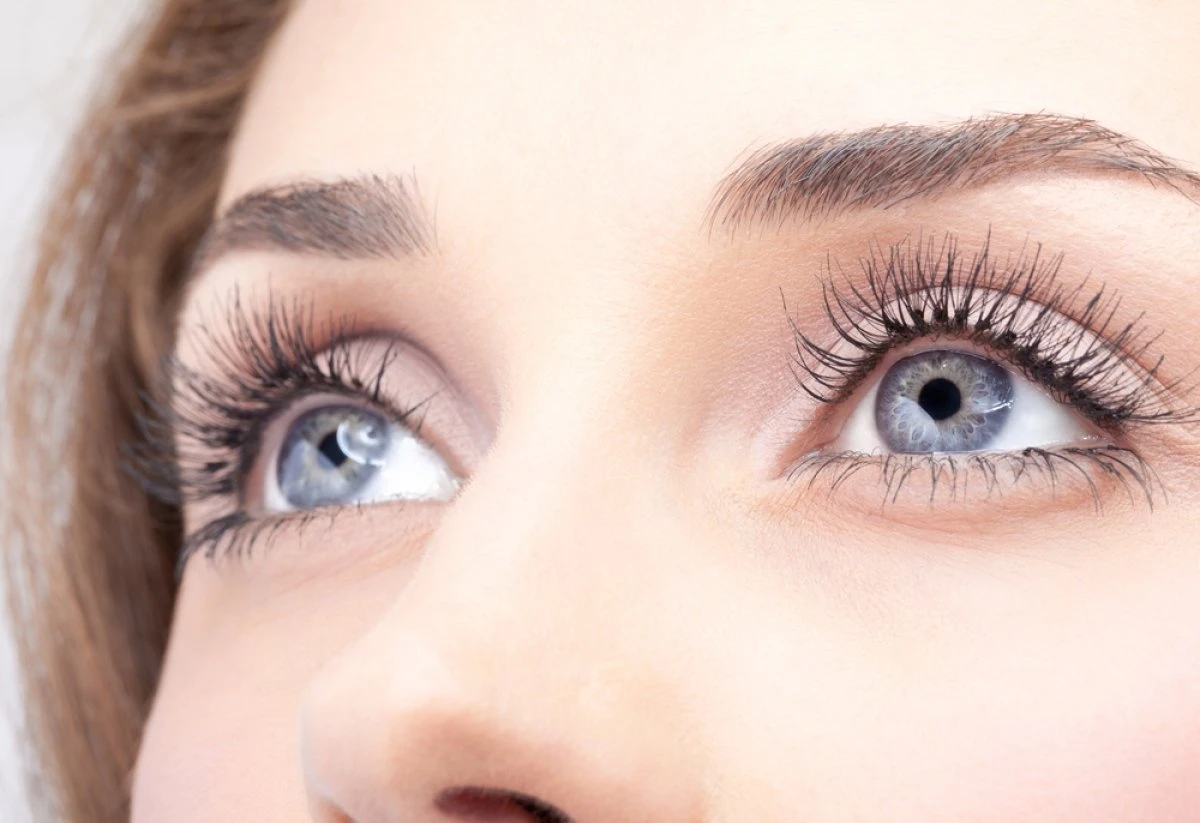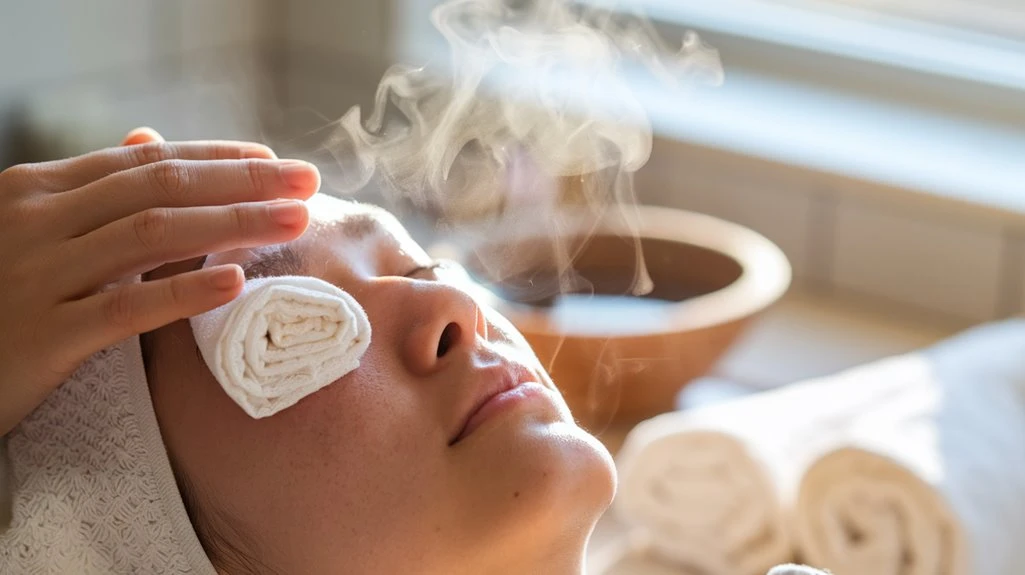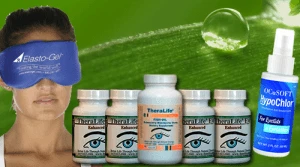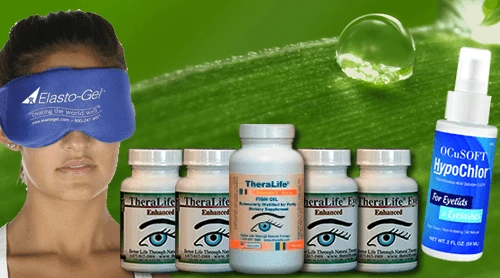If you’re managing blepharitis, it’s essential to consider the benefits of TheraLife’s products. TheraLife offers a comprehensive approach to alleviating symptoms associated with blepharitis and other eye conditions. Their products help liquefy blocked meibomian gland secretions, reduce bacterial colonization, and ease eyelid inflammation—all critical factors in managing blepharitis effectively. Consistent use can dissolve crusts, improve periocular hygiene, and deliver rapid relief from chronic symptoms. TheraLife emphasizes the importance of using sterile, safe materials and includes natural ingredients that have been proven to be effective, such as calendula. By integrating TheraLife’s clinically-backed strategy into your home care routine, you can achieve better eye health and comfort.
Best Blepharitis?MGD Treatment From TheraLife- When Drops Don’t Work.
Key Takeaways
- DIY compresses help liquefy blocked oils in the eyelid glands, reducing inflammation and improving blepharitis symptoms.
- Warm compresses naturally dissolve crusts and debris, promoting better eyelid hygiene and comfort.
- Herbal DIY compresses can provide soothing relief and mild antimicrobial effects using accessible, non-pharmacological ingredients.
- Making compresses at home allows for frequent, consistent treatment tailored to individual needs.
- DIY methods are affordable and empower patients to actively manage their blepharitis symptoms between clinical visits.
Understanding Blepharitis and Its Common Symptoms
Blepharitis is an inflammatory condition affecting the eyelid margins, commonly resulting from dysfunction of the meibomian glands, bacterial colonization, or seborrheic dermatitis.
You’ll often recognize blepharitis by hallmark symptoms such as eyelid erythema, pruritus, a gritty sensation, and the accumulation of crusts or oily debris at the eyelash base. These clinical features frequently accompany chronic irritation, fluctuating vision, and ocular surface discomfort.
Blepharitis causes include both anterior (Staphylococcus species, seborrheic dermatitis) and posterior forms (meibomian gland dysfunction).
When evaluating symptoms, thorough lid margin examination and history-taking are essential. Common treatments encompass lid hygiene protocols, topical antibiotics, and anti-inflammatory agents.
Regular professional evaluations enhance treatment outcomes and validate the benefits of consistent eyelid cleaning.
Diagnosis and management depend on identifying underlying etiologies to tailor interventions, prevent complications, and minimize symptom recurrence for ideal ocular surface health.
Benefits of Warm Compresses for Eye Health
When applied regularly, warm compresses facilitate liquefaction of meibum within the meibomian glands, promoting improved glandular secretion and alleviating obstructive symptoms. By enhancing meibomian gland function, you encourage effective tear film stabilization and reduce evaporative dry eye, both critical in thorough eye hygiene. Clinical studies underscore the efficacy of warm compresses as natural remedies, demonstrating significant reductions in ocular surface inflammation and symptomatic relief in cases of blepharitis. You’ll also boost lid margin cleanliness, as the heat aids in dissolving crusts and debris, limiting bacterial colonization. This simple intervention integrates therapeutic thermal therapy with daily hygiene, making it a cornerstone in non-pharmacologic management. As you incorporate warm compresses into your routine, you actively maintain periocular health and foster long-term symptomatic improvement. Additionally, maintaining eyelid cleanliness is essential in preventing flare-ups and reducing the risk of serious eye diseases associated with blepharitis.
Key Herbs to Include in a Compress for Blepharitis
When preparing an herbal compress for blepharitis, you should consider chamomile for its anti-inflammatory and soothing effects. Calendula offers epithelial repair and mild antimicrobial activity, making it suitable for sensitive periocular skin. Incorporate thyme due to its documented antibacterial properties, which can target common blepharitis-associated pathogens. Additionally, using warm compresses for 10 to 15 minutes can help melt and release oils from the meibomian glands, enhancing the effectiveness of your herbal remedies.
Chamomile’S Soothing Properties
Although chamomile is commonly regarded as soothing in traditional herbal remedies, current clinical evidence doesn’t support its inclusion as an effective or safe agent in compresses for blepharitis.
Despite chamomile tea’s reputation for anti-inflammatory and calming effects, studies don’t confirm its efficacy or safety when used near the ocular surface. The risk of hypersensitivity reactions, particularly allergic conjunctivitis, increases when you apply chamomile-derived products to the periocular area.
In addition, preparation inconsistencies with herbal remedies may lead to variable concentrations of bioactive compounds, raising concerns about predictability and tolerability. Warm compresses are recommended for blepharitis treatment as they help loosen clogged oils in eyelid glands, reducing inflammation and improving tear quality.
Ophthalmic guidelines don’t recommend chamomile for blepharitis compresses due to these uncertain safety and efficacy profiles. You should carefully evaluate evidence before considering chamomile tea or similar herbal remedies for eyelid hygiene or therapy.
Calendula for Gentle Healing
Given the lack of robust evidence for herbal agents like chamomile, it’s important to assess the clinical data for other plants such as calendula. If you’re considering calendula for a DIY compress, you’ll want to understand its documented herbal properties and how they may contribute to gentle healing in blepharitis. Clinical studies demonstrate that calendula exhibits anti-inflammatory, epithelial healing, and mild antimicrobial effects—providing a scientific basis for its use in periocular therapies.
| Component | Herbal Properties | Clinical Relevance |
|---|---|---|
| Flavonoids | Antioxidant, anti-inflammatory | Reduces eyelid irritation |
| Triterpenoids | Healing, anti-edematous | Supports tissue recovery |
| Saponins | Mild cleansing | Preserves tear film |
| Essential oils | Antimicrobial action | Limits pathogen growth |
| Polysaccharides | Moisturizing | Improves ocular surface comfort |
Rely on calendula benefits with an evidence-based approach to maximize safety and efficacy. Calendula’s anti-inflammatory properties are particularly beneficial in addressing the immune inflammatory mechanisms that play a crucial role in dry eye disease.
Antibacterial Power of Thyme
Despite its longstanding use in traditional medicine, thyme (Thymus vulgaris) stands out for its well-characterized antibacterial properties, supported by in vitro studies demonstrating efficacy against common pathogens implicated in blepharitis, including Staphylococcus aureus.
You’ll find that thyme benefits are attributed largely to its active constituents, particularly thymol and carvacrol, which exert robust antimicrobial effects at the cellular level. These phytochemicals disrupt bacterial cell membranes and inhibit microbial proliferation, directly addressing blepharitis-associated bacterial overgrowth.
Incorporating thyme in your DIY compress harnesses these key herbal properties, providing an adjunctive, evidence-based intervention. Clinical literature suggests that thyme extracts present low cytotoxicity to human cells, making them suitable for sensitive ocular tissues.
When preparing a compress, precise dosing optimizes antimicrobial efficacy while minimizing irritation—promoting effective, targeted relief. Regular eyelid hygiene is crucial to minimize symptom recurrence and enhance the efficacy of thyme compresses.
Best Blepharitis?MGD Treatment From TheraLife- When Drops Don’t Work.
Step-by-Step Guide to Making a Herbal Compress
Several precise steps are necessary to prepare a herbal compress suitable for blepharitis management.
Begin by selecting herbs with established anti-inflammatory and antimicrobial properties—chamomile, thyme, and calendula are evidence-based choices offering distinct herbal benefits.
Prepare an infusion by steeping one to two teaspoons of dried herbs in approximately 250 milliliters of boiling water for 10 minutes, maintaining infusion integrity for maximum therapeutic efficacy.
Strain the liquid through a sterile gauze to eliminate particulates.
For safe compress techniques, soak a clean cotton pad or sterile gauze in the warm herbal solution, wring out excess fluid, and apply the compress to closed eyelids.
Maintain contact for 5–10 minutes, revitalizing as needed. This technique guarantees ideal therapeutic contact and preserves clinical standards in home care routines.
When managing blepharitis, it’s important to consider thermal pulsation systems as they provide long-term benefits for meibomian gland function, complementing the use of herbal compresses.
Safety Tips for Using DIY Compresses Around the Eyes
Proper preparation of a herbal compress is only one aspect of effective blepharitis management; meticulous attention to safety mitigates the risk of ocular irritation and secondary infection.
Always verify your compress is freshly made, using sterile, lint-free cloth to prevent introduction of pathogens.
Verify the compress temperature with the dorsum of your hand—never apply excessively hot materials, as this can exacerbate eye irritation or cause burns.
Avoid direct contact with the ocular surface; position the compress gently over closed eyelids only.
Thoroughly cleanse hands before and after application to minimize microbial contamination.
Discontinue use if you notice increased redness, discomfort, or discharge, as these may indicate worsening inflammation or infection.
Maintaining good hygiene practices is crucial for managing blepharitis as it can significantly reduce the occurrence of flare-ups and related complications.
Adhering to compress safety protocols is paramount for protecting delicate periocular tissues and optimizing therapeutic outcomes.
How Often to Apply a Herbal Compress for Best Results
For ideal therapeutic effect, you should apply a herbal compress once or twice daily, as supported by current ophthalmologic guidelines. Monitor changes in eyelid erythema, debris, and discomfort to assess treatment efficacy. If symptoms persist or worsen, consult an eye care professional for further evaluation. Consistent use of warm compresses can help alleviate symptoms by melting blockages in the meibomian glands and improving overall eyelid hygiene.
Ideal Daily Application Frequency
Ideal results in managing blepharitis with a herbal compress typically depend on a consistent application schedule—most clinical protocols recommend applying the compress one to two times daily.
By standardizing your application timing, you guarantee that the therapeutic agents from the herbal compress maintain a steady anti-inflammatory effect on the eyelids.
Integrating this intervention into your daily routine optimizes compliance and maximizes the cumulative benefits, such as reduction of eyelid margin debris and meibomian gland dysfunction.
Conjunctival irritation might occur alongside blepharitis symptoms, and using a compress can help alleviate some of the associated discomfort.
Clinical evidence indicates that twice-daily compresses offer a balance between efficacy and convenience, though you might tailor frequency according to symptom severity or practitioner guidance.
Maintaining regular intervals—morning and evening—can facilitate better gland expression and symptom control without risking skin irritation from overuse.
Always maintain proper hygiene with each application.
Monitoring Eye Improvement
While regular use of a herbal compress promotes symptomatic control in blepharitis, tracking ocular improvement allows you to fine-tune treatment frequency for optimum efficacy.
You should establish a baseline by documenting presenting symptoms—such as eyelid edema, erythema, pruritus, and discharge—prior to initiating compress therapy. Monitoring symptoms daily after each compress application provides data to assess response dynamics.
Use a symptom diary or digital log to facilitate tracking improvements or exacerbations. Clinical evidence suggests that a decrease in inflammation and discomfort typically indicates adequate frequency, whereas persistent or worsening symptoms may necessitate adjustment of application intervals or further medical evaluation.
Recognizing When to Seek Professional Medical Advice
How do you know if your blepharitis symptoms require escalation to a healthcare professional? Recognizing when to seek expert evaluation is vital.
If you notice persistent erythema, severe eyelid edema, or refractory ocular discomfort despite consistent use of DIY warm compresses, these are signs requiring immediate attention.
Additional clinical indicators include significant visual acuity reduction, mucopurulent discharge, or development of eyelid lesions. Severe photophobia, escalating pain, or any deterioration in ocular function warrant urgent consultation, as they could signal progression to secondary complications like keratitis or orbital cellulitis.
Additional Home Care Practices to Soothe Blepharitis
In addition to routine warm compress application, several adjunctive home care strategies can help alleviate blepharitis symptoms and promote eyelid hygiene.
You should implement daily eyelid scrubs using a commercially available lid cleanser or a diluted solution of baby shampoo. Gently cleanse the lid margins to remove debris, reduce microbial load, and prevent meibomian gland obstruction.
Consider incorporating preservative-free artificial tears to enhance ocular surface lubrication and mitigate irritation. Strict avoidance of eye makeup, especially during active flare-ups, contributes to superior eye hygiene.
Some home remedies, such as omega-3 fatty acid supplementation, may improve meibum quality and support tear film stability. Maintain consistent hand hygiene before all periocular contact.
Best Blepharitis?MGD Treatment From TheraLife- When Drops Don’t Work.
Frequently Asked Questions
Can a DIY Compress Be Used Alongside Prescription Medications for Blepharitis?
You can safely use a DIY compress alongside prescription medications for blepharitis, as current evidence doesn’t indicate significant prescription interactions.
Warm compresses enhance treatment effectiveness by loosening debris and opening clogged glands, supporting antimicrobial or anti-inflammatory therapies.
However, always consult your ophthalmologist to guarantee your compress regimen complements your prescribed protocol.
They’ll tailor your care for best results, minimizing adverse effects and maximizing symptom relief in the context of your individual therapeutic plan.
Are There Any Compress Ingredients to Avoid for People With Allergies?
Imagine you use a compress with chamomile for blepharitis, but your eyelids become red and swollen—an indicator of an allergic response.
It’s essential to avoid herbal ingredients like chamomile, calendula, or lavender if you have known allergies, as these can trigger contact dermatitis or ocular irritation.
Opt for allergy alternatives such as sterile saline or water, minimizing immunologic risks while maintaining ocular surface health.
Always screen compress components for allergens before application.
How Should a Used Herbal Compress Be Stored Between Uses?
To guarantee ideal herbal storage and compress hygiene, you should place the used herbal compress in a clean, airtight container and refrigerate it between uses.
Don’t allow the compress to remain at room temperature, as this encourages microbial growth.
Before reapplying, inspect the compress for any discoloration or odor indicating contamination.
Always reheat the herbal compress to a safe, therapeutic temperature, and discard the compress after 24 hours to minimize infection risk.
What Are Signs of an Allergic Reaction to Compress Ingredients?
When using a compress, you should monitor for allergic symptoms to guarantee compress safety.
Watch for erythema (redness), pruritus (itching), localized edema (swelling), or urticaria (hives) at the site of application.
Ocular symptoms, such as increased tearing, burning, or conjunctival hyperemia, also indicate potential hypersensitivity.
If you notice these signs, discontinue use immediately and seek medical evaluation, as continued exposure may exacerbate inflammation and compromise ocular surface integrity.
Is It Safe to Use a DIY Compress on Children With Blepharitis?
When it comes to children’s health, you’re not just walking on eggshells—you’re handling fragile glass.
It’s essential to follow evidence-based safety guidelines when using a DIY compress on a child with blepharitis. Verify the compress’s temperature doesn’t exceed 40°C to prevent thermal injury.
Always use sterile, hypoallergenic materials to minimize risk of infection or irritation.
Consult your pediatrician, as individualized medical supervision remains the gold standard for ideal safety.
Best Blepharitis?MGD Treatment From TheraLife- When Drops Don’t Work.
Conclusion
Theralife.com’s products offer significant benefits to customers dealing with blepharitis and other eye conditions. By using Theralife’s targeted interventions, such as their herbal compresses and supplements, individuals can effectively manage inflammation and improve eye health. These products are based on clinical evidence and natural ingredients, providing a reliable solution for maintaining ocular homeostasis. Regular monitoring and using Theralife’s products as part of a comprehensive eye care routine can help preserve the delicate ecosystem of the eyes. However, it’s important to recognize when professional medical advice is necessary to ensure optimal eye health.





